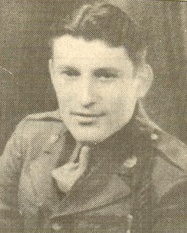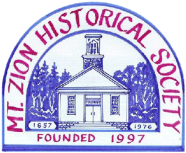Remembering
Private First Class John Silinsky Jr. (1922 - 1944)
US Army, WWII - Europe, KIA

Remembering - Private First Class John Silinsky Jr. by Evo G. Facchine
John Silinsky, Jr., born in Bell Hollow (Tyler), PA, on September 28, 1922, was the sixth of seven children born to John Silinsky, Sr. and Mary Scanish Silinsky. His early years were spent at that location where his father operated the Bell Hollow Poultry Farm.
In 1937 when John was fifteen years old the family moved to Weedville occupying a home on Route 255 just below the present motel. As a young boy John loved to roller skate and did so on the concrete highway in front of his home, mastering jumping over cracks and potholes in the pavement. He loved to hunt and fish and was also known for his sharp shooting prowess. He was known to fiddle tunes on a violin that his father made for him. He attended school in Weedville having graduated in June of 1941 after which he was employed at Keystone Carbon Company in St. Marys.
He entered the military service, via St. Marys draft board, in December of 1942 was assigned to Company L, 23rd Infantry Division. He received his basic training at Camp McCoy in the State of Wisconsin where he received training on skies and snowshoes operating in deep snow at temperatures as low as 45 degrees below zero .Coincidentally John’s older brother Stephen, living in Pittsburgh, thirty five years old, entered the service on the very same day through the Pittsburgh draft board.
At the completion of basic training John enjoyed his only furlough in the summer of 1943. This was followed by 15 day voyage across the Atlantic landing in Northern Ireland on October 20, 1943. There John’s outfit engaged in intensive training on the bleak Irish moors, in preparation for the invasion of France. Throughout John’s training period there were approximately twenty men from the Elk County area and particularly St.Marys in the 23rd Infantry. In interviews with one such fellow said he double dated with John, said John was a fun loving fellow and that another GI, now deceased, from Kersey was John’s foxhole buddy.
On June 7, 1944 the 23rd Infantry landed on Omaha Beach and proceeded inland in slow painful fighting against hard fighting German paratroop elements. One need only read the history of World War II from D-Day, June 6,1944 to the fall of St. Lo, July 17, 1944, to understand the agony of these brave men inching their way through the hedgerows. By July 24, 1944 the Normandy Campaign was considered complete. During that period D-Day to July 24 would prove to be the forth most costly period for the U S Army in Europe: 16,293 Killed in action and 41,051 wounded.
It was during these tremendously difficult days, actually on June 30, 1944 at about the time the 23rd reached the outskirts of St. Lo, France, that Private First Class John Silinsky was killed in action. Most likely in the famous Battle for St. George’s d’Elle, known to the men of the 23rd as Hill 192, the Hill that commanded St. Lo.
Reading John’s letters from his induction in December of 1942 to his last letter home on June 26, 1944 one could sense the transformation of a young innocent country boy into mature fighting man doing his duty in the defense of freedom and his county. In his own words, in his last letter, he put it this way: “I’ve been in action on the front lines for quite some time now and it isn’t what you call fun, but that’s what I’m in the Army for. I don’t care to talk about this anymore, I’m OK and that’s the main point.”
Meanwhile John’s brother Steve was moved from the Italian Campaign to France where on August 7th he learns of his brother’s death. To know Steve is to read his compassionate letter of that day to his mother, dad, sisters and brother back home. In that letter, Steve relates that the Chaplain has agreed to say a Mass for John that evening and his intent to visit John’s grave prior to returning to the front lines. And finally he can write no more because he wants to repeat what he has already written in trying to console the family from afar.
Always of interest is how the word of a soldier’s death reaches home. In the case of the wounded or missing in action it was normally by telephone to one of the few businesses in town that had a phone, delivered by the proprietor of the business followed by an official telegram within a day or so. Obviously a death deserved more consideration but not much more according to John’s sister, who was at home with her mother on that fateful day. She describes it this way, she and her mother were in the kitchen when a knock was heard at the door, neither wanted to answer it, but it fell to her to do so. Upon seeing the vehicle with Red Cross markings on it she knew it was serious. The delivery lady left without explanation and it was left to her to open the telegram. She remembers that at the time Steve was fighting in Italy, John was fighting in France, so there was some question as to the subject of the telegram. Once the telegram was opened it fell upon Helen to go to the nearest place with a phone, call her married sister in Emporium who then picked up her father at Corbett Cabinet and came home to the distraught Mother and sister.
Steve survived fighting in Italy, France and Germany, returned to DuBois where he operated a business known as Keystone Electric Motor Repair Company. He passed away in 1990.
A small sense of closure, in the vernacular of today, did not come until John’s remains were returned to the United States from his temporary interment in St. Laurent, France to the National Cemetery in Gettysburg, Pa. in February of 1948. But real closure never comes, so the family continued on, each mourning their loss, Mom and Dad for losing their baby boy, Steve, Mike, Anna, Tillie and Eva over the lose of their kid brother, and Helen over the loss of her big brother and her childhood playmate, the children of their marriages, and yes a sweetheart left behind, named Martha, all of them always wondering how much greater life would have been, if only “Johnny” would have come marching home again.
Lest We Forget…
